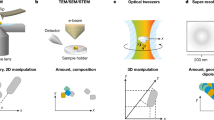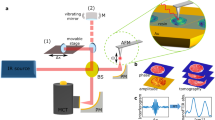Abstract
Electron microscopy has been instrumental in our understanding of complex biological systems. Although electron microscopy reveals cellular morphology with nanoscale resolution, it does not provide information on the location of different types of proteins. An electron-microscopy-based bioimaging technology capable of localizing individual proteins and resolving protein–protein interactions with respect to cellular ultrastructure would provide important insights into the molecular biology of a cell. Here, we synthesize small lanthanide-doped nanoparticles and measure the absolute photon emission rate of individual nanoparticles resulting from a given electron excitation flux (cathodoluminescence). Our results suggest that the optimization of nanoparticle composition, synthesis protocols and electron imaging conditions can lead to sub-20-nm nanolabels that would enable high signal-to-noise localization of individual biomolecules within a cellular context. In ensemble measurements, these labels exhibit narrow spectra of nine distinct colours, so the imaging of biomolecules in a multicolour electron microscopy modality may be possible.
This is a preview of subscription content, access via your institution
Access options
Access Nature and 54 other Nature Portfolio journals
Get Nature+, our best-value online-access subscription
$29.99 / 30 days
cancel any time
Subscribe to this journal
Receive 12 print issues and online access
$259.00 per year
only $21.58 per issue
Buy this article
- Purchase on Springer Link
- Instant access to full article PDF
Prices may be subject to local taxes which are calculated during checkout




Similar content being viewed by others
Data availability
The data sets generated during and/or analysed during the current study are available from the corresponding author on reasonable request.
References
Roth, J., Bendayan, M. & Orci, L. Ultrastructural localization of intracellular antigens by the use of protein A–gold complex. J. Histochem. Cytochem. 26, 1074–1081 (1978).
Martell, J. D. et al. Engineered ascorbate peroxidase as a genetically encoded reporter for electron microscopy. Nat. Biotechnol. 30, 1143–1148 (2012).
Lam, S. S. et al. Directed evolution of APEX2 for electron microscopy and proximity labeling. Nat. Methods 12, 51–54 (2015).
Adams, S. R. et al. Multicolor electron microscopy for simultaneous visualization of multiple molecular species. Cell Chem. Biol. 23, 1417–1427 (2016).
Sochacki, Ka, Shtengel, G., van Engelenburg, S. B., Hess, H. F. & Taraska, J. W. Correlative super-resolution fluorescence and metal-replica transmission electron microscopy. Nat. Methods 11, 305–308 (2014).
Carter, S. D. et al. Distinguishing signal from autofluorescence in cryogenic correlated light and electron microscopy of mammalian cells. J. Struct. Biol. 201, 15–25 (2018).
Fisher, P. J., Wessels, W. S., Dietz, A. B. & Prendergast, F. G. Enhanced biological cathodoluminescence. Opt. Commun. 281, 1901–1908 (2008).
Mahfoud, Z. et al. Cathodoluminescence in a scanning transmission electron microscope: a nanometer-scale counterpart of photoluminescence for the study of II–VI quantum dots. J. Phys. Chem. Lett. 4, 4090–4094 (2013).
Zhang, H., Glenn, D. R., Schalek, R., Lichtman, J. W. & Walsworth, R. L. Efficiency of cathodoluminescence emission by nitrogen-vacancy color centers in nanodiamonds. Small 13, 1700543 (2017).
Glenn, D. R. et al. Correlative light and electron microscopy using cathodoluminescence from nanoparticles with distinguishable colours. Sci. Rep. 2, 1–6 (2012).
Niioka, H. et al. Multicolor cathodoluminescence microscopy for biological imaging with nanophosphors. Appl. Phys. Express 4, 2402 (2011).
Cai, E. et al. Stable small quantum dots for synaptic receptor tracking on live neurons. Angew. Chem. Int. Ed. 53, 12484–12488 (2014).
Yokota, S. Effect of particle size on labeling density for catalase in protein A–gold immunocytochemistry. J. Histochem. Cytochem. 36, 107–109 (1988).
Kijanka, M. et al. A novel immuno-gold labeling protocol for nanobody-based detection of HER2 in breast cancer cells using immuno-electron microscopy. J. Struct. Biol. 199, 1–11 (2017).
Giepmans, B. N. G., Deerinck, T. J., Smarr, B. L., Jones, Y. Z. & Ellisman, M. H. Correlated light and electron microscopic imaging of multiple endogenous proteins using quantum dots. Nat. Methods 2, 743–749 (2005).
Bischak, C. G. et al. Cathodoluminescence-activated nanoimaging: noninvasive near-field optical microscopy in an electron microscope. Nano Lett. 15, 3383–3390 (2015).
Feng, W., Zhu, X. & Li, F. Recent advances in the optimization and functionalization of upconversion nanomaterials for in vivo bioapplications. NPG Asia Mater. 5, e75–15 (2013).
García De Abajo, F. J. Optical excitations in electron microscopy. Rev. Mod. Phys. 82, 209–275 (2010).
Wang, F., Deng, R. & Liu, X. Preparation of core–shell NaGdF4 nanoparticles doped with luminescent lanthanide ions to be used as upconversion-based probes. Nat. Protoc. 9, 1634–1644 (2014).
Liu, Q., Feng, W., Yang, T., Yi, T. & Li, F. Upconversion luminescence imaging of cells and small animals. Nat. Protoc. 8, 2033–2044 (2013).
Li, Z. & Zhang, Y. An efficient and user-friendly method for the synthesis of hexagonal-phase NaYF4:Yb, Er/Tm nanocrystals with controllable shape and upconversion fluorescence. Nanotechnology 19, 345606 (2008).
Ostrowski, A. D. et al. Controlled synthesis and single-particle imaging of bright, sub-10-nm lanthanide-doped upconverting nanocrystals. ACS Nano 6, 2686–2692 (2012).
Dong, A. et al. A generalized ligand-exchange strategy enabling sequential surface functionalization of colloidal nanocrystals. J. Am. Chem. Soc. 133, 998–1006 (2011).
Gargas, D. J. et al. Engineering bright sub-10-nm upconverting nanocrystals for single-molecule imaging. Nat. Nanotechnol. 9, 300–305 (2014).
Feng, W., Sun, L. D., Zhang, Y. W. & Yan, C. H. Solid-to-hollow single-particle manipulation of a self-assembled luminescent NaYF4:Yb,Er nanocrystal monolayer by electron-beam lithography. Small 5, 2057–2060 (2009).
Judd, B. R. Optical absorption intensities of rare-earth ions. Phys. Rev. 127, 750–761 (1962).
Ofelt, G. S. Intensities of crystal spectra of rare‐earth ions. J. Chem. Phys. 37, 511–520 (1962).
Chan, E. M. Combinatorial approaches for developing upconverting nanomaterials: high-throughput screening, modeling, and applications. Chem. Soc. Rev. 44, 1653–1679 (2015).
Fischer, S., Johnson, N. J. J., Pichaandi, J., Goldschmidt, J. C. & van Veggel, F. C. J. M. Upconverting core–shell nanocrystals with high quantum yield under low irradiance: on the role of isotropic and thick shells. J. Appl. Phys. 118, 193105 (2015).
Ma, C. et al. Optimal sensitizer concentration in single upconversion nanocrystals. Nano Lett. 17, 2858–2864 (2017).
Lu, Y. et al. Tunable lifetime multiplexing using luminescent nanocrystals. Nat. Photon. 8, 32–36 (2013).
Nawa, Y. et al. Dynamic autofluorescence imaging of intracellular components inside living cells using direct electron beam excitation. Biomed. Opt. Express 5, 378–386 (2014).
Xu, C. S. et al. Enhanced FIB-SEM systems for large-volume 3D imaging. eLife 3, 1–36 (2017).
Zhang, Z., Kenny, S. J., Hauser, M., Li, W. & Xu, K. Ultrahigh-throughput resolved super-resolution microscopy. Nat. Methods 12, 935–938 (2015).
DaCosta, M. V., Doughan, S., Han, Y. & Krull, U. J. Lanthanide upconversion nanoparticles and applications in bioassays and bioimaging: a review. Anal. Chim. Acta 832, 1–33 (2014).
Denk, W. & Horstmann, H. Serial block-face scanning electron microscopy to reconstruct three-dimensional tissue nanostructure. PLoS Biol. 2, e329 (2004).
Hayworth, K. J. et al. Ultrastructurally smooth thick partitioning and volume stitching for large-scale connectomics. Nat. Methods 12, 319–322 (2015).
Kasthuri, N. et al. Saturated reconstruction of a volume of neocortex. Cell 162, 648–661 (2015).
Stephenson, R. S. et al. High resolution 3-dimensional imaging of the human cardiac conduction system from microanatomy to mathematical modeling. Sci. Rep. 7, 7188 (2017).
Angelo, M. et al. Multiplexed ion beam imaging of human breast tumors. Nat. Med. 20, 436–442 (2014).
Acknowledgements
This work was supported by the Gordon and Betty Moore Foundation (grant no. 4309), the National Institutes of Health (1R01GM128089-01A1) and the National Cancer Institute CCNE-TD at Stanford University (U54CA199075). Work at the Molecular Foundry was supported by the Office of Science, Office of Basic Energy Sciences, of the US Department of Energy under contract no. DE-AC02–05CH11231. Part of this work was performed at the Stanford Nano Shared Facilities (SNSF), supported by the National Science Foundation under award ECCS-1542152. Access to the JEOL TEM 1400 was provided through the Stanford Microscopy Facility, NIH grant SIG no. 1S10RR02678001. M.B.P. was supported by the Helen Hay Whitney Foundation Postdoctoral Fellowship, and P.C.M. was supported through the Stanford Neuroscience Interdisciplinary Award. M.D.W. and J.A.D. acknowledge financial support provided as part of the DOE ‘Light–Material Interactions in Energy Conversion’ Energy Frontier Research Center under grant no. DE-SC0001293, as well as funding provided by the Global Climate and Energy Project at Stanford University. The authors thank N. Ginsberg and C. Aiello for providing software used in time-gated CL imaging experiments and for discussions. The authors are also grateful to J.J. Perrino and D.H. Burns for providing expertise in electron microscopy and for discussions, and R. Walsworth, D. Glenn, H. Zhang, T.C. Sudhof, J. Trotter, J. Collins and X. Zheng for discussions.
Author information
Authors and Affiliations
Contributions
M.B.P., P.C.M. and S.C. conceived the project, designed experiments, analysed the data and interpreted the results. M.B.P. and P.C.M. conducted CL imaging experiments and wrote software for data analysis. M.B.P., P.C.M., A.M.C., N.L., M.D.W., C.S., B.T., G.S. and S.F. synthesized and characterized rare-earth nanoparticles. E.C. provided software for the simulation of the nanoparticle spectra. S.A., D.F.O., E.S.B. and L.-M.J. provided assistance and expertise in electron microscopy hardware and sample preparation. D.F.O. and S.A. developed the CL optics, and E.S.B. and D.F.O. developed the CL software. S.C. supervised the research. J.R., A.P.A., R.M.M., B.E.C., Y.C. and J.A.D. supervised the relevant portions of the research such as sample preparation and training M.B.P. and P.C.M. on the nanoparticle synthesis. M.B.P., P.C.M. and S.C. wrote the manuscript.
Corresponding author
Ethics declarations
Competing interests
The authors declare no competing interests.
Additional information
Publisher’s note: Springer Nature remains neutral with regard to jurisdictional claims in published maps and institutional affiliations.
Supplementary information
Supplementary Information
Supplementary Text and Supplementary Figures 1–30
Rights and permissions
About this article
Cite this article
Prigozhin, M.B., Maurer, P.C., Courtis, A.M. et al. Bright sub-20-nm cathodoluminescent nanoprobes for electron microscopy. Nat. Nanotechnol. 14, 420–425 (2019). https://doi.org/10.1038/s41565-019-0395-0
Received:
Accepted:
Published:
Issue Date:
DOI: https://doi.org/10.1038/s41565-019-0395-0
This article is cited by
-
Proof of crystal-field-perturbation-enhanced luminescence of lanthanide-doped nanocrystals through interstitial H+ doping
Nature Communications (2023)
-
Time-correlated electron and photon counting microscopy
Communications Physics (2023)
-
Diffusion dynamics and characterization of attogram masses in optically trapped single nanoparticles using laser-induced plasma imaging
Nano Research (2023)
-
Cathodoluminescence imaging of cellular structures labeled with luminescent iridium or rhenium complexes at cryogenic temperatures
Scientific Reports (2022)
-
Dynamic upconversion multicolour editing enabled by molecule-assisted opto-electrochemical modulation
Nature Communications (2021)



